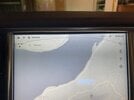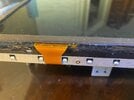hahaha *sugar* i did all this while it was in the car an on. only had to pull off the trim to access the screws to pull it out a little to access the top of it where the bubbles were. I felt the screen with the needle and right behind the glass it slid right in without issue. I kept it angled resistance towards the glass so i didn't accidently have the potential to stab the actual screen
Awesome, more MCU1 leaking display surgery update.
Needle
This definitely works to get air out. Need the following
- 30 gauge (0.3mm diameter) >0.75 inch length needle. Here is sample spec
BD PrecisionGlide™ 30 G x 1" Hypodermic Needles - 305128 – Medsitis
Unfortunately difficult to find. 5 pharmacies/3 chains near me didn't have it. Only found 0.3mm 0.5" length which can barely get to the edge of the bubbles closest to the edge. The short needle unfortunately clogs easily and can't reach bubbles even a couple of mm from the edge.
Will need multiple needles. Useless after clogged with the plasma goo.
Also tried 0.4mm diameter needle, doesn't fit. Too big.
BTW, Pharmacist might look at you funny thinking you are drug addict or not too helpful with a 30 cent/free item haha. Covid19 vaccination seems to be causing a shortage as well.
Bubble Extraction
Extracting the air bubbles is quite an interesting process. Face the screen upwards standing on the metal mounting legs so glass weight sits on the plasma seam. Due to the thick viscosity, when pulling the syringe plunger, bubble doesn't shrink immediately (or my short needle got some plasma goo clogging right away) but will feel the vacuum force on the plunger. After 10s+, bubble and nearby bubbles starts to get narrower and further from the edge. My 1/2" needle can't reach anymore. When the needle pulls out, the vacuum actually kind of seal the entry channel. If not immediately, seems eventually.
Screen Assembly
Also got a better idea of how the touch screen layers are setup. Here is summary and pic
A. 1/16" top protective glass. This is the glass you touch
B. top capacitive touch circuit layer (majority of the flex cable lines goes to here so probably some kind of matrix). Typically use transparent conductive material.
C. 1/8" glass
D. bottom capacitive touch circuit layer. Looks like just 1 line on each of the 4 edges of the screen. Probably something like a common ground. Typically use transparent conductive material.
E. Plasma
F. LCD
G. Diffuser/backlight etc.
Needle goes into E and I'm guessing D might just be a plane so tolerant of any needle scratches (don't know for sure but airborne spoon and I haven't damaged anything poking in here, my touch screen worked fine after getting some air out)
Plasma Cleanup
My bubble originate mid point on the passenger edge of the screen. This is right under the touch screen flex tape on that edge. After disconnecting the flex tape from touch screen board (pic in post #19) and removing the screw/washer that holds the tape down, could unfold the tape to reveal the plasma seam under the tape. It was the heaviest leaking spot on my MCU display.
Clean up is probably the most challenging part of the job before sealing that edge with epoxy. Iso Alcohol definitely doesn't work. Might have to just patiently pick away at it. But once the leak is really bad, not sure how it can clean enough to be sealed by epoxy. Resealing might be a repair technique reserved for preventive and initial bubbling.
Anyway, flex tape bonding to the class is fragile but durable enough to handle unfolding the tape to reveal and clean the seam underneath + reseal.
Anyhow, looking for longer needle now to get the rest of the bubbles and see if possible to clean off leaked plasma and epoxy reseal. Note my plasma leak is not heavy enough to be visible externally or onto the rear of the bezel. Only along the seam and behind one of the flex tape glass connections. Even then, need to find a good way to clean it off before applying epoxy sealant.
Resealing Decisions
One downside of resealing with epoxy is needle air removal will no longer be possible if still have air leak. Contemplating starting with resealing the bottom 2/3 of the screen first to see how things go.
Instrument Panel
Since the panel bezel is off for MCU removal, discovered also had air bubble on top edge hidden by the bezel. The LCD has a silver (metal?) surrounding edge bracket and the front glass mounts onto that with the plasma goo underneath. Mine had lots of bubble on the top silver edge. The front glass flexes quite easily so can just push on it to squeeze the air out. But they soon appear again as top glass returns back to its shape. Don't know if plasma volume changed or top glass/LCD warped and increased volume.
Since there is solution to remove/clean the plasma off instrument panel completely, not sure worth epoxy resealing (makes removing the glass and cleaning plasma much harder if not impossible)
Here is a pic after pressure removed most of the air bubbles. But they soon returned.




